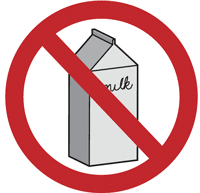
Food Allergy vs. Intolerance: Know the Difference
Understanding the difference between food allergies and food intolerances can leave a person justifiably confused. With these medical conditions having potential overlapping symptoms (e.g., cramps, upset stomach, diarrhea, skin rash, and headache), it is easy to see why the line separating the two is so often blurred.
Allergy
 Food allergy (also called hypersensitivity) involves an inappropriate immune reaction to a seemingly harmless, non-pathogenic substance. The body reacts to the substance as if it were fighting a disease-producing microorganism. On first exposure to the offending food, the body’s immune system produces antibodies called immunoglobin E (IgE), which are specific to that allergen. With any subsequent exposure, the allergen binds to the IgE antibodies, which triggers the immune system to initiate a more rapid and aggressive response. This intense reaction can produce oral inflammation, canker sores, cramps, nausea, diarrhea, gas, hives, and sometimes can produce respiratory distress.1
Food allergy (also called hypersensitivity) involves an inappropriate immune reaction to a seemingly harmless, non-pathogenic substance. The body reacts to the substance as if it were fighting a disease-producing microorganism. On first exposure to the offending food, the body’s immune system produces antibodies called immunoglobin E (IgE), which are specific to that allergen. With any subsequent exposure, the allergen binds to the IgE antibodies, which triggers the immune system to initiate a more rapid and aggressive response. This intense reaction can produce oral inflammation, canker sores, cramps, nausea, diarrhea, gas, hives, and sometimes can produce respiratory distress.1
Symptoms can appear immediately after eating or could take several hours to appear and can range from mild to severe. The most severe reaction, anaphylactic shock, affects the whole body, with symptoms usually presenting within one hour following contact. Symptoms include wheezing, difficulty breathing, swelling of the throat and tongue, vomiting, and fainting. Anaphylaxis can be deadly and requires immediate medical attention.2 People with known allergies should carry an auto-injector of epinephrine, a medicine that counteracts the reaction, in case of exposure to the food.
Food allergies affect as many as 5-6% of young children and 3-4% of adults in Westernized countries.3 Allergies tend to run in families and are more common in children than they are in adults, as some children outgrow their food allergies over time. Allergies to eggs, milk, wheat, soy, and peanuts cause the most problems in children, while adults most often suffer from allergies to peanuts, tree nuts, fish, and shellfish.2
Intolerance
 In contrast to food allergy, food intolerance does not involve the body’s immune system. Intolerance is an adverse reaction to a food, likely to originate in the gastrointestinal system, usually caused by a limited ability or an inability to digest or absorb certain foods or their components. Food intolerance symptoms usually begin about half an hour after eating or drinking the food in question, but in some circumstances may not appear for up to 48 hours. Symptoms include nausea, bloating, abdominal pain, and diarrhea. Two examples of food intolerance are:
In contrast to food allergy, food intolerance does not involve the body’s immune system. Intolerance is an adverse reaction to a food, likely to originate in the gastrointestinal system, usually caused by a limited ability or an inability to digest or absorb certain foods or their components. Food intolerance symptoms usually begin about half an hour after eating or drinking the food in question, but in some circumstances may not appear for up to 48 hours. Symptoms include nausea, bloating, abdominal pain, and diarrhea. Two examples of food intolerance are:
- Lactose Intolerance: Up to 70% of the world’s population is unable to consume milk or dairy products without getting an upset stomach.4 Typically, the human body can produce the enzyme lactase, which helps digest the sugar found in milk (lactose); however, people who are lactose intolerant do not produce a sufficient quantity of lactase and, therefore, digestion of milk-containing foods is not adequate. Undigested lactose lingers in the intestine and ferments, causing abdominal pain, bloating, diarrhea, and flatulence. For more information on lactose intolerance, contact our office.
- Non-Celiac Gluten Intolerance: Although people with celiac disease must strictly abide by a gluten-free diet to prevent damage to their intestines, many non-celiac individuals are finding that avoiding gluten improves their gastrointestinal symptoms, hence the growing popularity of gluten-free foods. Despite limited scientific literature to prove its existence, this so-called “non-celiac gluten intolerance” or “wheat intolerance” is believed to be quite common.5 In one double-blind, randomized, placebo-controlled trial, patients reported that gluten induced symptoms of bloating, dissatisfaction with stool consistency, abdominal pain, and tiredness. There is no evidence that non-celiac gluten intolerance causes damage to the small intestine.6
| Food Allergy | Food Intolerance | |
| Immune System Activated | Yes | No |
| Exposure Required to Elicit Symptoms | Tiny quantity | Normal size portion |
| Timeframe for Reaction After Exposure | Immediate – 1 or 2 hrs | 30 min – 48 hrs |
| Treatment | Food avoidance, medicines (antihistamines, epinephrine shot) | Food limitation or complete avoidance, depending on severity |
On February 16, 2011 Health Canada published amendments to its Food Allergen Labelling Regulations.[7] The current guidelines require that most pre-packaged foods carry a label and that the ingredients appear on labels in decreasing order of proportion. When the new amendments come into effect on August 4, 2012 some ingredients used in food products that were previously exempt will now be required to appear on food labels. It is Health Canada’s intention to make it simpler for those with food allergies, and sensitivities or intolerances, to avoid contact with an undeclared ingredient that could potentially lead to serious health consequences. For more information please visit Health Canada.
Want to learn more about allergy and intolerance?
We have several related articles that may be helpful:
- 10 Myths about Food Allergies
- Food Allergy vs. Intolerance
- Gut Bacteria Protect Against Nut and Other Allergies
- Intestinal Gas from Complex Carbohydrates or Lactose Intolerance
- Is Your Gut Friend or Foe?
- Shedding Light on Peanut Allergies
- Yeast and Mould Allergy

